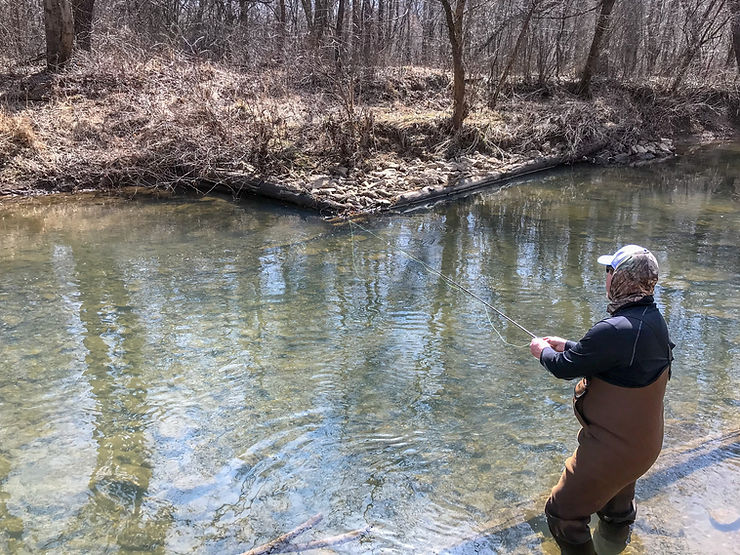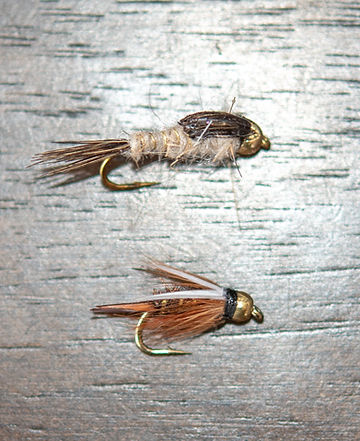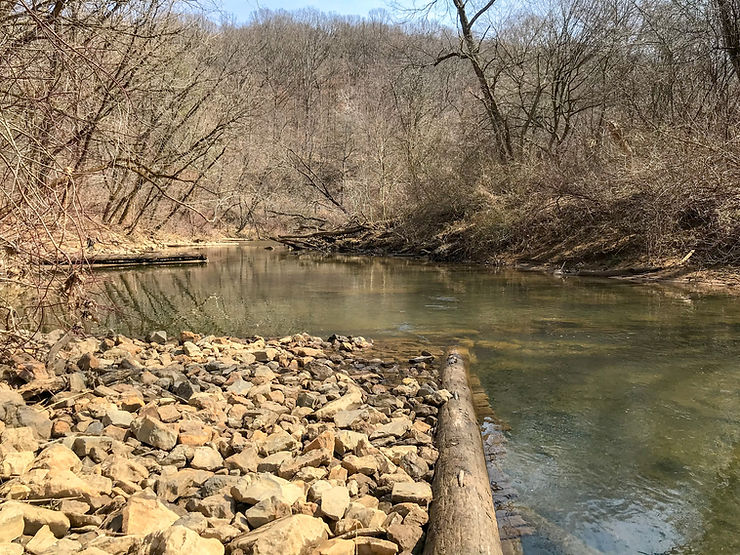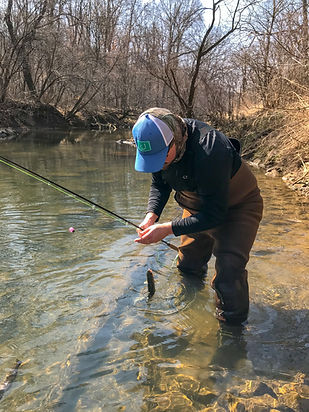Low Water Tactics: Fishing the Buffalo Creek DHALO

With only half a day to fish last week, I opted for home waters. I was due to pick my two kids up at daycare that afternoon, so I didn’t want to wander too far in my travels and waste most of my day on the road rather than on the water. Considering the time constraints, the Buffalo Creek DHALO seemed like the most practical option.
This day, my longtime friend Greg Harold joined me. It was his first outing of the year, and after a couple hours with nary a nibble, we both started getting that dejected feeling that comes with a tough day on the water. Or as Greg said, “It’s been so long since I caught a fish, I’m starting to wonder if I forgot how to do it.”
The water was low and clear. Over the years, I’ve seen the stream running this low and clear this early in the year only a handful of times. These conditions can be challenging, especially when that stream is Buffalo Creek, which was stocked on February 20th and has been fished heavily every day since.
At one point, I decided to walk along the stream, peering into each pool hoping to locate trout. I walked right past a group of about 20 without realizing it. They were either blended in that well, or my defeatist attitude had me expecting not to see anything anyway. As I was walking back downstream, I saw them, though, and I slipped into the water without spooking them.
(When the fish can obviously see you, I often wonder what they think. I can hear Greg’s voice in my head: “Look at that jackass up there, that’s what they think.”)
The fish all but ignored every fly drifted through their ranks. I fished with and without an indicator, with and without weight, standard nymphs, flashy nymphs, egg patterns, and a wide assortment of junk patterns. Not a single trout showed any interest at all.

Greg came over and gave it a shot, too. As he did, I climbed up on the bank and circled around to fish from an upstream position. I had one more trick up my sleeve – a size 8 white Krystal Bugger – and I wanted to swing it over top of the group of trout. And, more importantly, I wanted to be able to hold the fly longer in their strike zone, let them really see it and fire them up.
The old mantra for fly or lure selection goes like this: bright colors on bright days, dark colors on dark days. How fish see and interpret color is product of many factors, including water depth and clarity as well as weather conditions such as overhead cloud cover. Whole books have been devoted to this subject. Although I understand the reasoning behind why certain colors work on certain days, choosing the brightest and flashiest fly in my box seemed counterintuitive, but what the heck. Nothing else was working.
I’ve always believed that almost any stocked trout can be caught as long as it’s not spooked – a spooked fish, regardless of species, is practically uncatchable until it forgets the reason it spooked. Even trout that appear completely uninterested need to eat. And if you want to see lethargic trout liven up, show them a white Krystal Bugger in the middle of a bright sunny day.
The pool came alive. Instead of hugging the stream bottom, motionless, trout seemed to raise up a bit and their tails flickered in the easy current. Several trout swiped at the bugger, nipping its tail. On the next pass, one grabbed it and splashed around for a few seconds before throwing the hook.
I changed positions slightly, fishing them from more of a side angle rather than directly downstream. Boom! First fish of the day, a scrappy little rainbow that inhaled the fly.
After a few more hits and misses, their interest waned, so I switched to a Prince Nymph under an indicator. First pass through the pool, hello, second trout of the day!
When water conditions are less than favorable, and trout less than cooperative, sometimes you just need to wake them up. A bright, flashy Krystal Bugger can certainly do that. Years ago, when I still used a spinning rod and bait, if I came to a pool of lethargic trout, I’d run a spinner over their heads a few times to rile them up and get them interested in feeding. It didn’t even matter if I caught any on the spinner. Nine times out of ten, when I switched back to whatever bait I had on me, I’d catch a fish on the first cast.
This same tactic is deadly in fly fishing, too. The caveat, of course, is trout that are keyed in on one specific insect or mayfly species. But during the early season, and especially in streams such as Buffalo Creek where there are no dominant hatches (at least none like what you find on many of the premier fly streams in this state), you can definitely put fish into a feeding frenzy by showing them something off the wall.
Buffalo Creek does have a great Black Stonefly hatch, though, and that day with Greg, quite a few stoneflies were in the air and on the water, although no trout were rising for them. My favorite stonefly pattern for fishing Buffalo Creek isn’t necessarily a stonefly pattern at all. It’s a Prince Nymph.

On the Buffalo Creek DHALO, I’ve caught more trout in March and April on Prince Nymphs than probably all other fly patterns combined. I tie my Prince Nymphs on a standard dry fly hook (pictured in the photo). In fact, recently I’ve been tying most of my nymphs on this hook because I like the shorter profile as opposed to the standard 2XL nymph hook (such as the Hare’s Ear Nymph in the photo). This is just my preference, and when streams are low and clear, I like the smaller fly profile while still having the hooking power of a larger hook. If you want to use an actual nymph hook, consider a hook model that is 2X or 3X short with a wide gap and you’ll end up with a similar looking fly.
After landing a couple of trout, I conceded the pool to Greg, who had yet to catch anything. I sat on the bank and offered suggestions on presentation and how to get the fly where it needed to be. Greg is one of the best bass fishermen I know but relatively new to fly fishing. He fly fishes only a few times per year but is a good student and a fast learner. In no time, he had his first trout of 2021, caught on the Prince Nymph.
Once trout got tired of the Prince Nymph, I tied the white Krystal Bugger onto Greg’s tippet. The fish livened up again, and Greg soon had his second trout of the year.
As I sat there watching Greg catch trout, it occurred to me that I’ve been fishing the DHALO section of Buffalo Creek since 1991, when DHALOs were first established in Pennsylvania. That’s also the year the PA Fish & Boat Commission created the Trout/Salmon Permit. In fact, in response to that permit, Trout Unlimited lobbied for the establishment of more special catch and release sections on our streams and increased fishing opportunities. It’s been a win-win for everyone, in my opinion.
Over the last 30 years, I’ve fished Buffalo Creek in the neighborhood of 600 times. That’s one of the perks of growing up less than 10 minutes from the stream. Starting in March and continuing on through July, I could be found on some part of Buffalo Creek for at least a short period of time almost every day.
I remember when the Arrowhead Chapter of Trout Unlimited first started working on Buffalo Creek by installing deflectors and adding various structures to prevent erosion and deal with siltation issues. When projects first began, the stream was on the brink of decline, but still had a lot of great holding water. And then all of a sudden that holding water was gone, and if it weren’t for the many stream improvement devices installed by TU the past 20 years or so, the entire DHALO section might very well be ankle deep today.

Trout use the deflectors for cover at all times of year, especially when water levels are low and clear. You’ll often see fish move in and out from the shadows under these manmade structures. So if a pool looks barren, you can bet the trout are probably tucked up under a deflector.

I imagine this is the case on any stream where lots of stream improvements have been done. That’s the goal of these projects after all, to create fish habitat and holding water. If you’re not having much success, drifting your fly right up against these structures can be extremely productive. Almost on cue, Greg’s fly bounced off the log frame and plopped into the water and a trout darted out from under and smacked it.
Eventually it was time for me to leave to pick up my kids from daycare, but Greg stayed and continued fishing. That evening, he texted me his report. He’d moved downstream to a pool around the bend and happened upon another group of trout. These fish were much more cooperative and hungry. “The white bugger is killer,” his text read, and I didn’t doubt it.
Low and clear water can make for challenging fly fishing. Changing up patterns and presentations, and sometimes going against the grain with something completely off the wall, can turn a slow day into a great day. That’s true on the Buffalo Creek DHALO, and it’s true just about anywhere trout live.
Sign up for the Dark Skies Fly Fishing e-newsletter
It's free, delivered to your inbox approximately three times each month. Your information is always kept private and used for the sole purpose of keeping you up to date on blog posts and specials in the online store.
Sign Up Now